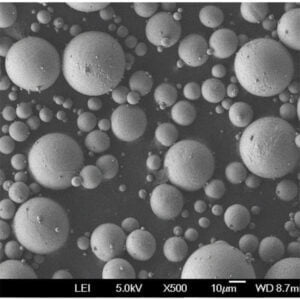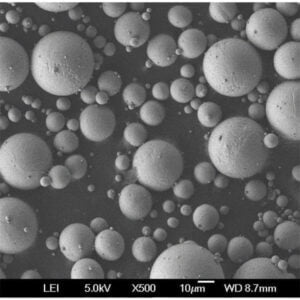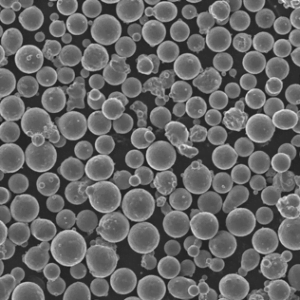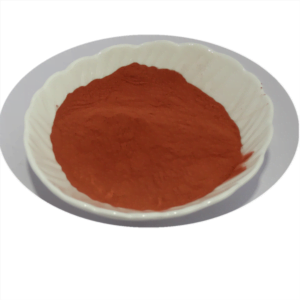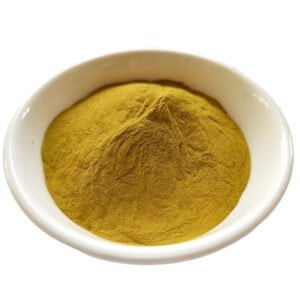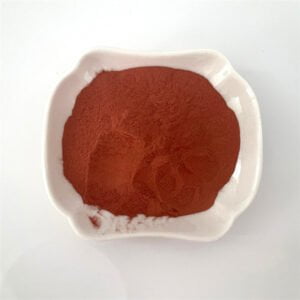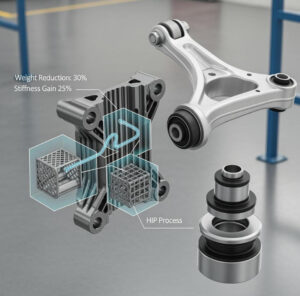Vacuum Induction Melting
Table of Contents
Overview of Vacuum Induction Melting
Vacuum induction melting (VIM) is a sophisticated and essential process in the metallurgy industry, used primarily to produce high-quality metal alloys. By melting metals under a vacuum, this method minimizes the risk of contamination from gases and impurities, resulting in superior material properties. It’s widely employed in industries where high purity and specific alloy compositions are critical, such as aerospace, medical devices, and high-performance engineering components.
Understanding Vacuum Induction Melting
Vacuum induction melting works by utilizing electromagnetic induction to heat and melt metals in a vacuum-sealed environment. The vacuum conditions reduce the presence of oxygen, nitrogen, and hydrogen, which can cause defects in the final product. This process ensures that the metals produced have excellent mechanical properties, high purity, and controlled compositions.
Key Components and Process
- Induction Furnace: The core of the VIM process, using alternating current to create an electromagnetic field that induces heat in the metal.
- Vacuum Chamber: Encloses the induction furnace, ensuring that melting occurs in a vacuum or inert atmosphere.
- Power Supply: Provides the necessary electrical power for induction heating.
- Cooling System: Maintains appropriate temperatures and prevents overheating.
Benefits of Vacuum Induction Melting
- High Purity: Eliminates contaminants, producing exceptionally pure metals.
- Precise Control: Allows for precise control over alloy compositions.
- Superior Mechanical Properties: Enhances the material’s strength, ductility, and overall performance.
- Versatility: Suitable for a wide range of metals and alloys.
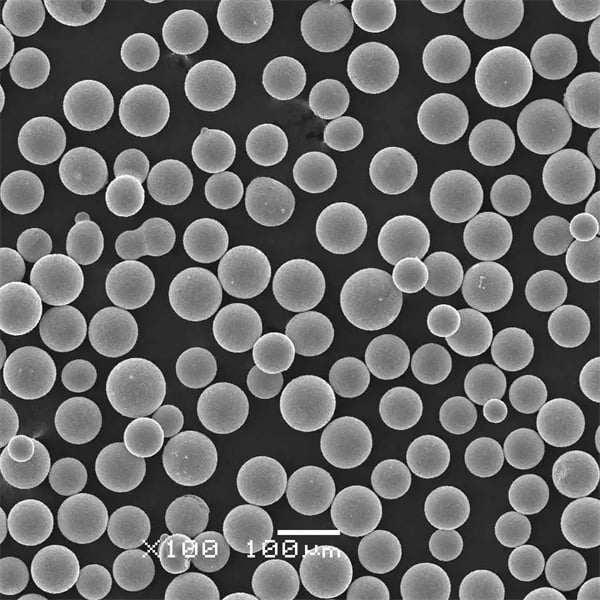
Types of Metal Powders Produced Using Vacuum Induction Melting
Common Metal Powders and Their Uses
| Metal Powder | Composition | Properties | Applications |
|---|---|---|---|
| Nickel Alloy 625 | Ni, Cr, Mo, Nb | High strength, corrosion-resistant | Aerospace, marine, chemical processing |
| Titanium Alloy Ti-6Al-4V | Ti, Al, V | High strength-to-weight ratio, biocompatibility | Medical implants, aerospace |
| Cobalt-Chromium Alloy | Co, Cr, Mo | Wear-resistant, biocompatible | Dental and orthopedic implants |
| Inconel 718 | Ni, Cr, Fe, Nb, Mo | High temperature resistance, strength | Gas turbines, nuclear reactors |
| Stainless Steel 316L | Fe, Cr, Ni, Mo | Corrosion-resistant, good weldability | Medical devices, food processing |
| Aluminum Alloy 7075 | Al, Zn, Mg, Cu | High strength, lightweight | Aerospace, sporting goods |
| Tool Steel H13 | Fe, Cr, Mo, V | High toughness, wear resistance | Die casting, extrusion tools |
| Copper Alloy C18200 | Cu, Cr | High conductivity, corrosion resistance | Electrical components, welding electrodes |
| Magnesium Alloy AZ91D | Mg, Al, Zn | Lightweight, good castability | Automotive, electronics |
| Tantalum | Pure Ta | High melting point, corrosion-resistant | Chemical processing, electronics |
Applications of Vacuum Induction Melting
Vacuum induction melting is utilized across various industries to produce components that require high integrity and specific material properties. Here are some key applications:
| Industry | Components Produced |
|---|---|
| Aerospace | Turbine blades, engine components |
| Medical | Implants, surgical instruments |
| Automotive | High-performance engine parts |
| Electronics | Conductive materials, semiconductor components |
| Energy | Turbine components, nuclear reactor parts |
Specifications, Sizes, Grades, and Standards
When dealing with metal powders and components produced via vacuum induction melting, it’s crucial to adhere to specific standards and specifications to ensure quality and performance. Below is an overview of common specifications:
| Material | Specifications | Sizes | Grades | Standards |
|---|---|---|---|---|
| Nickel Alloy 625 | ASTM B446, AMS 5666 | Various sizes | UNS N06625 | ISO 9001, AS9100 |
| Titanium Alloy Ti-6Al-4V | ASTM F136, AMS 4911 | Various sizes | Grade 5 | ISO 5832-3, ASTM F136 |
| Stainless Steel 316L | ASTM A240, A276 | Various sizes | UNS S31603 | ISO 9001, ASTM A276 |
| Inconel 718 | ASTM B637, AMS 5663 | Various sizes | UNS N07718 | ISO 9001, AS9100 |
| Tool Steel H13 | ASTM A681, AISI H13 | Various sizes | Grade H13 | ISO 9001, ASTM A681 |
Comparing Pros and Cons of Vacuum Induction Melting
| Advantages | Disadvantages |
|---|---|
| High Purity: Produces metals with fewer impurities and defects. | Cost: High initial setup and operational costs. |
| Controlled Atmosphere: Minimizes contamination from gases and other elements. | Complexity: Requires skilled operators and precise control systems. |
| Versatility: Can be used for a wide range of metals and alloys. | Scale: Limited batch sizes compared to other methods. |
| Enhanced Properties: Improves mechanical properties and performance of metals. | Maintenance: Requires regular maintenance of the vacuum system and induction furnace. |
Major Suppliers and Pricing Details
When sourcing metal powders and components produced through vacuum induction melting, it’s essential to consider suppliers’ reputations, quality standards, and pricing. Here is a summary of some notable suppliers:
| Supplier | Location | Products | Pricing (Approx.) |
|---|---|---|---|
| ATI Metals | USA | Nickel alloys, titanium alloys | $50 – $200/kg |
| Carpenter Technology | USA | Specialty alloys, stainless steel | $40 – $180/kg |
| Sandvik Materials Technology | Sweden | Stainless steel, high-performance alloys | $30 – $150/kg |
| VSMPO-AVISMA | Russia | Titanium alloys | $60 – $220/kg |
| H.C. Starck Solutions | Germany | Refractory metals, advanced alloys | $70 – $250/kg |
Advantages and Limitations of Vacuum Induction Melting
Advantages
- Purity and Quality: One of the most significant benefits of VIM is the ability to produce extremely pure metals, essential for high-performance applications.
- Precise Alloy Composition: The process allows for precise control over the alloying elements, ensuring that the final product meets exact specifications.
- Improved Mechanical Properties: Metals produced through VIM often exhibit superior mechanical properties, such as increased strength, toughness, and resistance to fatigue and corrosion.
Limitations
- High Costs: Both the setup and operational costs of vacuum induction melting are high, which can be a barrier for smaller companies or low-volume production.
- Complex Operation: The process requires highly skilled operators and sophisticated control systems to maintain the necessary conditions for quality production.
- Batch Size: The size of batches that can be produced is often smaller compared to other melting processes, which can limit production capacity.
Comparing Vacuum Induction Melting with Other Melting Processes
| Parameter | Vacuum Induction Melting | Electric Arc Melting | Air Induction Melting |
|---|---|---|---|
| Purity | High | Moderate | Low |
| Cost | High | Moderate | Low |
| Control Over Composition | Excellent | Good | Fair |
| Batch Size | Small to Medium | Medium to Large | Large |
| Mechanical Properties | Superior | Good | Fair |
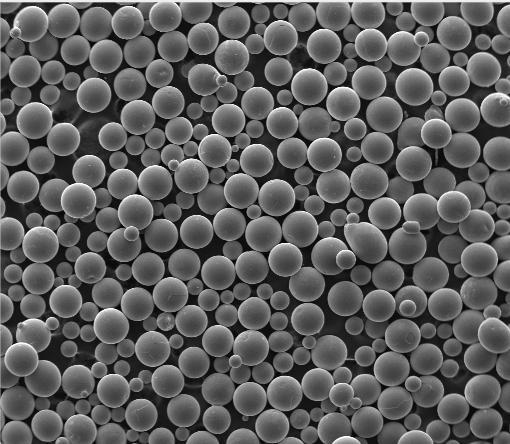
FAQs
| Question | Answer |
|---|---|
| What is Vacuum Induction Melting? | Vacuum induction melting is a process that uses electromagnetic induction to melt metals in a vacuum-sealed environment to produce high-purity alloys. |
| Why is a vacuum used in this process? | The vacuum reduces the presence of gases such as oxygen, nitrogen, and hydrogen, which can cause impurities and defects in the metal. |
| What types of metals can be melted using VIM? | Various metals including nickel, titanium, cobalt, stainless steel, and more can be melted using VIM. |
| What industries commonly use VIM? | Aerospace, medical, automotive, electronics, and energy industries commonly use VIM to produce high-performance components. |
| What are the benefits of using VIM over other melting processes? | VIM offers higher purity, better control over alloy composition, and superior mechanical properties compared to other melting processes. |
| Are there any limitations to using VIM? | Yes, VIM can be costly and complex, requiring skilled operators and precise control systems. It also typically handles smaller batch sizes. |
know more 3D printing processes
Frequently Asked Questions (FAQ)
1) What defects does Vacuum Induction Melting most effectively reduce?
- VIM mitigates gas-related defects (H, O, N), nonmetallic inclusions, and segregation by melting under controlled vacuum and inert backfill, improving fatigue life and cleanliness (per ASTM E45 inclusion ratings).
2) How do VIM and VAR differ, and when are they combined?
- VIM controls chemistry and removes dissolved gases during primary melting; Vacuum Arc Remelting (VAR) refines solidification structure and reduces segregation. High-integrity alloys (e.g., Ni-base superalloys, Ti alloys) often use VIM + VAR to meet aerospace/medical specs.
3) What vacuum levels are typical in VIM?
- Roughing to high vacuum during degassing: ~10−1 to 10−3 mbar (10−2 to 10−5 atm), followed by inert backfill (argon) for pouring. Exact setpoints depend on alloy vapor pressures and hydrogen/oxygen removal targets.
4) Which standards are most relevant for VIM quality control?
- ISO 9001/AS9100 for QMS, ASTM E1447 (H in Ti alloys), ASTM E1019 (O, N, H in steels/Ni-base), AMS 2300/2301 (cleanliness), and alloy-specific specs like AMS 5662/5663 (Inconel 718) or ASTM F136 (Ti-6Al-4V implants).
5) What are key cost drivers in VIM operations?
- Electrical energy for induction, vacuum pump power, crucible/lining consumption, yield losses, backfill gases (Ar), downtime for maintenance, and scrap/return rates. Batch size and alloy volatility (e.g., Al, Mg) also affect cost.
2025 Industry Trends
- Dual-melt adoption rises: More VIM+VAR and VIM+ESR routes to meet tighter inclusion/delta-ferrite and low-H limits in aerospace and medical supply chains.
- Decarbonization: Facilities publish cradle-to-gate CO2e per kg of VIM-produced ingot; argon recovery, heat recuperation, and green power PPAs become common.
- Digital twins and melt analytics: Inline mass spectrometry and model-predictive control stabilize chemistry and reduce re-melts.
- Regionalization: North America/EU expand domestic VIM capacity to de-risk critical materials (Ti, Ni, Co) and comply with procurement rules.
- Powder integration: VIM feedstock optimized for subsequent gas atomization to produce AM-grade powders with lower O/N and controlled tramp elements.
Key 2023–2025 metrics and outlook for Vacuum Induction Melting
| Metric | 2023 Baseline | 2024 Typical | 2025 Outlook | Notes/Sources |
|---|---|---|---|---|
| Typical furnace capacity (metric tons/heat) | 0.5–8 | 0.5–10 | 0.5–12 | Larger VIMs commissioned for Ni/Ti alloys |
| Vacuum level during degassing (mbar) | 1E−1–1E−2 | 1E−2–1E−3 | 1E−2–1E−3 | Deeper vacuum for H/O removal |
| Argon consumption per heat (Nm³) | 80–180 | 70–160 | 60–140 | Argon recycling reduces use |
| Energy intensity (kWh/ton, Ni alloys) | 650–900 | 600–850 | 550–800 | Efficiency + heat recovery |
| CO2e footprint (kg CO2e/kg ingot, grid-average) | 6–9 | 5–8 | 4–7 | Varies with electricity mix |
| Dual-melt (VIM+VAR) share in aerospace Ni | 58–65% | 62–70% | 68–75% | Tighter specs/cleanliness |
| AM-grade powder yields from VIM feed | 35–45% | 38–48% | 40–50% | Improved atomization controls |
Authoritative references:
- ASTM standards portal — https://www.astm.org
- SAE/AMS specifications — https://www.sae.org
- ISO standards — https://www.iso.org
- Nickel Institute technical resources — https://nickelinstitute.org
- ASM International handbooks — https://www.asminternational.org
Latest Research Cases
Case Study 1: Reducing Hydrogen in Ti-6Al-4V via Deep-Vacuum Degassing (2025)
- Background: A medical implant supplier experienced variable hydrogen content causing delayed cracking in finished Ti-6Al-4V bars.
- Solution: Implemented extended deep-vacuum hold (≤1E−3 mbar) at superheat prior to argon backfill; added real-time residual gas analysis (RGA) to track H2 and H2O; tightened scrap mix controls.
- Results: Average H reduced from 130 ppm to 65 ppm (per ASTM E1447); reject rate dropped by 42%; fatigue limit improved by ~8% on rotating beam specimens; compliance with ASTM F136 maintained.
Case Study 2: VIM Feedstock Optimization for Gas Atomized Inconel 718 Powder (2024)
- Background: An AM powder house saw elevated oxygen and Laves phase in LPBF builds using IN718 powder.
- Solution: Shifted to VIM heats with tighter Al+Ti control, minimized reverts with surface oxides, and optimized vacuum pour to reduce air entrainment; downstream gas atomization under higher-purity argon with inline oxygen monitoring.
- Results: Powder O reduced from 0.045 wt% to 0.026 wt%; LPBF density increased from 99.1% to 99.5%; as-built tensile UTS improved by ~3% and hot crack incidence decreased measurably on standardized coupons.
Expert Opinions
- David Gandy, Ph.D., Director of Materials Technology, Electric Power Research Institute (EPRI)
- “For high-temperature components, coupling VIM chemistry control with dense downstream spray or additive routes is a practical path to extend life while managing cost and schedule risk.”
- Dr. Cemal Cem Tasan, Professor of Metallurgy, Massachusetts Institute of Technology
- “Process-integrated sensors in VIM—particularly residual gas analysis and adaptive induction power—are enabling tighter control over interstitials, directly impacting fatigue-critical applications.”
- Dr. Sandra J. Face, Principal Metallurgist, Aerospace Alloys Consultant
- “Dual-melt (VIM+VAR) remains the benchmark for nickel superalloys destined for rotating hardware; inclusion population and segregation control are still the gating metrics for certification.”
Practical Tools/Resources
- Standards and specifications
- ASTM E1019 (O, N, H by inert gas fusion), ASTM E1447 (H in Ti), ASTM E45 (inclusions), AMS 5662/5663 (IN718), ASTM F136 (Ti-6Al-4V implants)
- ISO 17025 (lab competence) for test labs supporting VIM shops
- Process modeling and control
- Thermo-Calc and JMatPro for phase stability and segregation modeling
- Residual Gas Analyzers (RGAs) for inline monitoring (e.g., Pfeiffer/Inficon)
- Data and references
- ASM Handbooks Online (Heat Treating, Metallurgy of Titanium/Nickel) — https://www.asminternational.org
- Nickel Institute alloy datasheets — https://nickelinstitute.org
- SAE MOBILUS for AMS access — https://saemobilus.sae.org
- Safety and operations
- NFPA 86 (ovens/furnaces), vacuum safety practices, PPE for induction/high-voltage operations
- Argon conservation and oxygen deficiency monitoring guidelines (OSHA) — https://www.osha.gov
- Supplier qualification
- Nadcap Heat Treating (AC7102) accreditation database — https://www.eauditnet.com
- AS9100-certified foundries/directories for aerospace supply chains
Implementation checklist for Vacuum Induction Melting
- Define melt route: VIM only vs. VIM+VAR/ESR based on end-use certification.
- Control inputs: certified revert management; low-O/N/H charge materials; calibrate scales and spectrometers.
- Vacuum and thermal profile: target ≤1E−2–1E−3 mbar during degassing; stabilize superheat before pour.
- Monitor in-process: RGA trends for H2/H2O/CO; quick OES/LECO confirmation for chemistry/interstitials.
- Pour and solidification: inert backfill, controlled pour to minimize re-oxidation and shrinkage porosity.
- Verify outputs: inclusion ratings (ASTM E45), interstitials (E1019/E1447), macroetch, ultrasonic inspection (per AMS/NDT).
Sources for deeper reading:
- ASTM, ISO, SAE/AMS standard catalogs (links above)
- ASM Handbook, Vol. 15: Casting; Vol. 1 & 2: Properties and Selection
- EPRI materials reports on turbine alloys
- Peer-reviewed literature via SpringerLink/Elsevier on VIM and dual-melt metallurgy
Last updated: 2025-10-28
Changelog: Added 5 new VIM-focused FAQs; introduced 2025 trends with KPI table and decarbonization notes; provided two recent case studies; compiled expert opinions; added tools/resources and an implementation checklist with standards and safety references
Next review date & triggers: 2026-06-30 or earlier if AMS/ASTM specs change, major OEMs update melt route requirements, or facility energy/argon recovery technologies materially impact KPIs
Share On
MET3DP Technology Co., LTD is a leading provider of additive manufacturing solutions headquartered in Qingdao, China. Our company specializes in 3D printing equipment and high-performance metal powders for industrial applications.
Inquiry to get best price and customized Solution for your business!
Related Articles
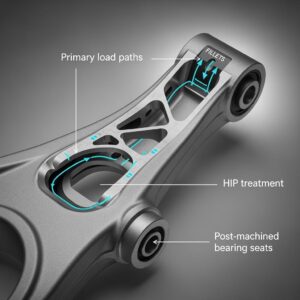
Metal 3D Printing for U.S. Automotive Lightweight Structural Brackets and Suspension Components
Read More »About Met3DP
Recent Update
Our Product
CONTACT US
Any questions? Send us message now! We’ll serve your request with a whole team after receiving your message.







